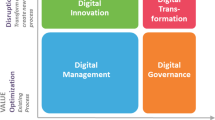Abstract
Higher education faces increasing pressures to change to better meet the needs of modern society. Systemic change applies systems thinking and systems theory to change a complex system to a new paradigm. This paper argues for the need for the systemic change of higher education and presents educational technologists as particularly well placed to lead this change.
Similar content being viewed by others
References
Adelman, C. 2009. The Bologna Process for U.S. Eyes: Re-learning Higher Education in the Age of Convergence, Institute for Higher Education Policy, Washington.
Altbach, P. G., Reisberg, L., & Rumbley, L. E. (2009). Trends in global higher education: Tracking an academic revolution: UNESCO 2009 World Conference on Higher Education.
Banathy, B. H. (1992). A systems view of education: Concepts and principles for effective practice. Englewood Cliffs, New Jersey Educational Technology Publications.
Boyce, M. (2003). Organizational learning is essential to achieving and sustaining change in higher education. Innovative Higher Education, 28(2), 119–136.
Bromage, A. (2006). The Management of Planned Change: An Interdisciplinary Perspective. In L. Hunt, A. Bromage & B. Tomkinson (Eds.), The Realities of Change in Higher Education: Interventions to Promote Learning and Teaching (pp. 1–14). New York, NY: Routledge.
Bruininks, R. H., Keeney, B., & Thorp, J. (2010). Transforming America’s universities to compete in the “new normal”. Innovative Higher Education, 35, 113–125.
Bureau of Labor Statistics (2013). College enrollment and work activity of 2012 high school graduates. Retrieved June 6, 2013, from http://www.bls.gov/news.release/hsgec.nr0.htm
Duffy, F. M., & Reigeluth, C. M. (2010). The school system transformation protocol. In F. M. Duffy (Ed.), Dream! Create! Sustain!: Mastering the art and science of transforming school systems (pp. 199–215). Lanham, MD: Rowman & Littlefield.
Jongbloed, B., Enders, J., & Salerno, C. (2008). Higher education and its communities: Interconnections, interdependencies and a research agenda. Higher Education, 56, 303–324.
Henderson, C., & Dancy, M. H. (2011). Increasing the Impact and Diffusion of STEM Education Innovations, New Orleans, LA.
Hopkins, D. (2002). The evolution of strategies for educational change: Implications for Higher Education. LTSN Geeneric Centre. Retrieved July 6, 2011 from http://www.heacademy.ac.uk/assets/York/documents/resources/database/id193_The_Evolution_of_Strategies_for_Educational_Change.rtf
Houston, D. (2007). Rethinking quality and improvement in higher eduation.
Kezar, A. J. (2001). Understanding and facilitating organizational change in the 21st century:Recent research and conceptualizations. ASHE-ERIC Higher Education Report, 28(4).
Kezar, A., & Eckel, P. (2002). Examining theinstitutional transformation process: The importance of sensemaking, interrelated strategies, and balance. Research in Higher Education, 43(3), 295–328.
Meadows, D. H. (1999). Leverage points: Places to intervene in a system. Hartland, VT: Sustainability Institute.
Reigeluth, C. M. (1994). The imperative for systemic change. In C. M. Reigeluth & R. J. Garfinkle (Eds.), Systemic change in education. Englewood Cliffs, NJ: Educational Technology Publications.
Reigeluth, C. M. (2006). A leveraged emergent approach to systemic transformation. TechTrends, 50(2), 46–47.
Reigeluth, C. M., Watson, W. R., & Watson, S. L. (2012). Personalized Integrated Educational Systems: Technology for the information-age paradigm of education in higher education. In S. P. Ferris (Ed.), Teaching, learning, and the Net Generation: Concepts and tools for reaching digital learners (pp. 41–60). Hershey, PA: IGI Global.
Splitt, F. G. (2003). The Challenge to change: On realizing the new paradigm for engineering education. Journal of Engineering Education, 92(2), 181–187.
Taylor, P., Parker, K., Fry, R., Cohn, D., Wang, W., Velasco, G., & Dockterman, D. (2011). Is College Worth It?. Pew Social and Demographic trends.
Trow, M. (2007). Reflections on the transition from elite to mass to universal access: Forms and phases of higher education in modern societies since WWII. In J. J. F. Forest & P. G. Altbach (Eds.), International Handbook of Higher Education (pp. 243–280). Dordrecht, Netherlands: Springer.
van Driel, J. H., Verloop, N., Inge van Werven,H., & Dekkers, H. (1997). Teachers‘ craft knowledge and curriculum Innovation in Higher Engineering Education. Higher Education, 34(1), 105–122.
Watson, S. L., & Reigeluth, C. M. (2008). The learner-centered paradigm of education. Educational Technology, 48(5), 42–48.
Watson, S. L., Watson, W.R., & Reigeluth, C. M. (2008). Systems Design for Change in Education and Training. In J. M. Spector, M. D. Merrill, J. van Merrienboer, & M. P. Driscoll (Eds.), Handbook of Research on Educational Communications and Technology (3rd ed.). New York, NY: Lawrence Erlbaum
Author information
Authors and Affiliations
Corresponding authors
Rights and permissions
About this article
Cite this article
Watson, W.R., Watson, S.L. Exploding the Ivory Tower: Systemic Change for Higher Education. TECHTRENDS TECH TRENDS 57, 42–46 (2013). https://doi.org/10.1007/s11528-013-0690-9
Published:
Issue Date:
DOI: https://doi.org/10.1007/s11528-013-0690-9




